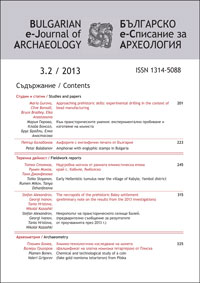Approaching prehistoric skills: experimental drilling in the context of bead manufacturing
Approaching prehistoric skills: experimental drilling in the context of bead manufacturing
Author(s): Clive Bonsall, Elka Anastassova, Bruce Bradley, Maria GurovaSubject(s): Archaeology
Published by: Асоциация на българските археолози
Keywords: Prehistoric skills; micro perforators/borers; pump drill; drilling; experiments; beads; (bio)minerals; Mohs scale
Summary/Abstract: From the very Early Neolithic in the Balkans two categories of objects are recognized as having been involved in prehistoric drilling activities. The first is beads and other decorative and prestigious items made of bone, shell, pottery and various minerals. The second comprises toolkits of micro-perforators/borers found among the flint assemblages of several sites. This paper presents experiments in drilling different materials with the aim of testing several practical issues. A series of micro-borers were produced and used for manual and mechanical drilling (with a pump drill). Various samples (mainly prepared thin plates) of minerals and rocks were used, ranging in hardness (on Mohs scale) from 3 (marble, limestone, calcite) to 6.5 (amazonite, nephrite). Biominerals were also used: aragonite (shells) and apatite (bones). Actual bead production was approached by manufacturing 16 delicate beads of 5 different materials using fine sand and water abrasion. Though not conclusive, the experimental work was instructive in many of the parameters, procedures and technical details of prehistoric drilling.
Journal: Българско е-Списание за Археология
- Issue Year: 3/2013
- Issue No: 2
- Page Range: 201-221
- Page Count: 20
- Language: English

